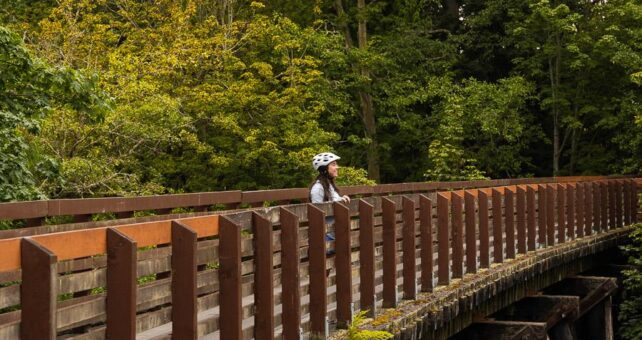Illinois’ Route 66 Trail Case Study
Illinois’ Route 66 Trail
Photo courtesy iStock by Getty Images
Revitalizing the “Mother Road” for Transportation, Recreation and Historic Preservation
Project Details
Lead Authority: McLean County
Total Project Cost: $14,340,000
Funding Pledged to Date: $6,667,066
Federal: $1,253,897
State: $4,325,560
Local: $1,087,609
Shovel-Ready: Three years or less
Type: Suburban, rural
Transformative Impact
Job Creation: An estimated 283 directly1
Transportation: Provides local connections between schools, parks and commercial areas strengthening neighboring communities by creating long-distance bicycling facilities.
Economic Impact: Annual Route 66 spending totals $132 million from Main Street businesses, cultural heritage tourism and museums. Tourists usually spend between $1,500 and $2,000.2 For every $1 invested in tourism in Illinois, $9 in economic impact are generated.3
Health Impact: Increased access to safe bike and pedestrian facilities for tourists as well as the more than 1 million residents living within 1 mile of the Route 66 Corridor.4
Project Description
Illinois’ Route 66 Trail is a visionary project that will help preserve one of America’s historic corridors while serving as a spine for Illinois’ trail networks. When complete, the trail will span 369 miles from Chicago to St. Louis—providing an incredible opportunity to walk or bike along sections of the original brick and pavement of the legendary Route 66 that once served as a highway gateway to the West. Illinois recognizes the significance of Route 66 to their past and future, and in the past several years, increased resources and funds have been directed toward the trail and other related preservation projects. Development of the trail is being championed primarily at the local level, with municipal investment aimed to bolster Main Street economies and connect communities, neighborhoods and parks.
McLean County has shown exceptional commitment as it leads the charge in completing its segment of the trail—set to be 37.2 miles long, with 16.5 miles complete by the end of the year. With additional state funding, local governments would be able to fill the 20.7-miles of gaps that exist between already completed sections of the trail. Providing a transportation resource to both residents and tourists, this part of the trail has significant potential to increase spending and health for the county. New trails would connect Lexington and Chenoa to Towanda, Bloomington-Normal, McLean, Shirley and Funks Grove. These towns have plans in place for their trail infrastructure investments, are committed to contributing local funds to restore the “Mother Road” and will continue to petition for state funding.
SOURCES
1 Estimated at 17 jobs per $1 million spent, according to a study commissioned by the American Association of State Highway and Transportation Officials (AASHTO) on American Recovery and Reinvestment Act (ARRA) job creation; jobs in terms of full-time equivalents
2 National Trust for Historic Preservation, available at https://savingplaces.org/stories/route-66-economic-benefits#.XKy0UihKgdU
3 Former Illinois Governor Bruce Rauner highlighted from the State tourism report, available at https://media.enjoyillinois.com/press-releases/illinois-office-of-tourism-announces-robust-growth/
4 Route 66 Economic Impact Study (number of residents is from 2010), available at https://www.wmf.org/sites/default/files/article/pdfs/Route%2066%20Economic%20Impact%20Study%E2%80%94Synthesis.pdf

Donate
Everyone deserves access to safe ways to walk, bike, and be active outdoors.
